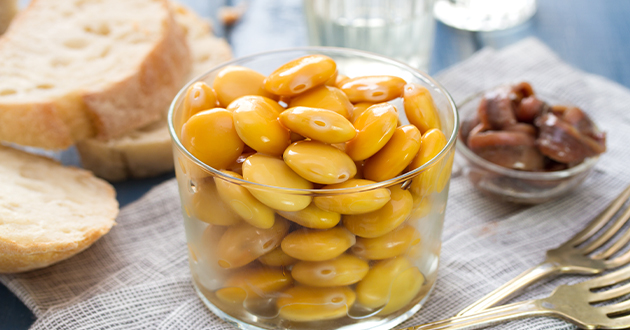Lupin/Lupini beans High in Protein and Fiber
Lupin/Lupini beans High in Protein and Fiber
Lupines are famous as attractive flowering plants because of their brightly colored flowers in pink, purple, blue, orange, and other colors. There are more than 200 varieties of lupine in one word! They are widely distributed worldwide, including in North and South America and along the Mediterranean coast. Among the wide varieties of lupines, a few seeds are used as "lupin beans" for food. These species include Lupinus mutabilis (scientific name), white-flowered lupine (scientific name Lupinus albus), yellow-flowered lupine (scientific name Lupinus luteus), and blue-flowered lupine (scientific name Lupinus angustifolius).
Lupine beans are flat and shaped like a pebble.
History of Lupin Beans

Lupinus mutabilis seeds have been used in the Andean highlands for more than 6,000 years, and white-flowered lupine seeds have been used as a food and herbal medicine in Egypt, Greece, and other Mediterranean countries for more than 3,000 years.
With such a long history, lupin beans are now one of the trendy foods among people who are mindful of their health. They contain as much protein as soybeans, the "meat of the plant," while low in fat and carbohydrates. The ketogenic diet (carbohydrate-restricted diet), which is highly popular among celebrities, basically excludes wheat flour and legumes. Still, lupin beans and flour made from lupin beans with low carbohydrate content are allowed to be consumed.
Lupin beans are sold as dried beans and in snacks and pickled. Lupin flour, which is gluten-free, is used as a substitute for wheat flour or as an ingredient in baked goods and pasta.
Lupin Beans: Main Nutrition Facts
It is rich in protein, fiber, vitamin A, B1, folic acid, vitamin C, manganese, magnesium, iron, copper, calcium, phosphorus, and zinc. And amino acids! It also contains various amino acids, including the nine essential amino acids our body cannot produce. In addition, it has antioxidants such as phenols and flavonoids.

Health Benefits of Lupin Beans
Abundant dietary fiber - improves digestive function, boosts immunity, and prevents cardiovascular disease and diabetes.
In addition to stimulating bowel movements, dietary fiber acts as a prebiotic (food for good bacteria) to improve the intestinal environment. Since approximately 70% of immune cells exist in the intestines, a good intestinal environment also enhances the immune system. In addition, by improving digestive function, nutrients in food are adequately absorbed, leading to overall health. Furthermore, dietary fiber effectively prevents cardiovascular disease and diabetes by lowering cholesterol and suppressing a rise in after-meal blood glucose levels.
Cardiovascular Benefits
Lupin beans are also rich in arginine. Arginine, a nonessential amino acid, can be synthesized by the body. Still, since it is responsible for various functions, more than the amount produced by the body itself is required. Arginine is also suitable for stimulating the secretion of growth hormones and improving erectile dysfunction (ED). In addition, arginine is an essential precursor of nitric oxide (NO); NO is a vasodilator, softening blood vessels and improving blood flow and blood pressure. Thus, myocardial infarction, atherosclerosis, and stroke can be prevented by alleviating cardiovascular stress levels.
Lupin beans also contain a small amount of phytic acid. In a study using a mouse model of atherosclerosis, it was reported that the protein in lupin beans containing phytic acid reduced the calcification of the aorta.
Prevention of Anemia
Lupin beans contain iron, the main ingredient of hemoglobin, and vitamin C, which helps iron absorption.
Stronger Bones

It contains high levels of minerals essential for the formation and maintenance of bone tissue, including calcium and magnesium. It is also effective in preventing osteoporosis.
Healthy Skin and Hair
80-85% of hair constituents are protein. Most of this is keratin, which is composed of 18 amino acids. To maintain healthy hair, adequate amounts of protein must be consumed. One hundred grams of cooked lupin beans contain 25.8 grams of protein.
In addition, the antioxidants in lupin beans prevent aging signs of the skin (spots and wrinkles) caused by UV damage.
Cooking Methods
Like other beans, lupin beans have a high alkaloid content, which is toxic and intensely bitter. If dried beans are used, they should be soaked and rinsed repeatedly as a prior treatment for cooking.
The powdered type can be used as a substitute for flour in confectionery and cooking.
Precautions
Lupines (seed: lupine bean) and peanuts ( peanut) are the same legume family members. If you are allergic to peanuts, please be aware that lupin beans may also cause allergic reactions.
Reference:
Systematic Biology, Volume 61, Issue 3, May 2012, Pages 443–460 SR Legacy Food Category: Legumes and Legume Products FDC ID: 172424 NDB Number:16077 FDC Published:4/1/2019 SR Legacy Food Category: Legumes and Legume Products FDC ID: 174271 NDB Number:16109 FDC Published:4/1/2019 Clin Exp Immunol. 2008 Sep;153 Suppl 1(Suppl 1):3-6. doi: 10.1111/j.1365-2249.2008.03713.x. Int J Angiol. Spring 2008;17(1):7-22. DOI: 10.1055/s-0031-1278274. J Clin Transl Endocrinol. 2014 Nov 29;2(1):6-13. doi: 10.1016/j.jcte.2014.07.007. eCollection 2015 Mar. PeerJ. 2014 Oct 14;2:e619. doi: 10.7717/peerj.619. eCollection 2014. J Food Sci Technol. 2016 Dec;53(12):4141-4148. DOI: 10.1007/s13197-016-2384-8. Epub 2016 Dec 3. Journal of Food Composition and AnalysisVolume 25, Issue 2, March 2012, Pages 190-197
* These statements have not been evaluated by the Food and Drug Administration. This product is not intended to diagnose, treat, cure, or prevent any disease.

 US Dollar
US Dollar

